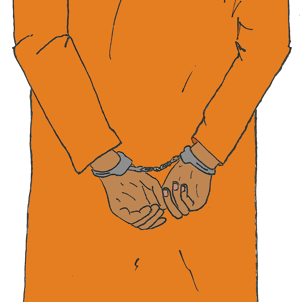Artist collaboration: Visualizing 10.6 million jail admissions each year
The real impact of jail is far greater than the daily population suggests: People go to jail 10.6 million times each year. We collaborated with data journalist and illustrator Mona Chalabi to visualize just how vast a number 10.6 million jail admissions is.
by Wendy Sawyer, March 22, 2018
 This is one jail admission.
This is one jail admission.
A staggering 731,000 people are held in local jails across the U.S. every day. But the real impact of jails is actually far greater: People go to jail 10.6 million times each year. We collaborated with data journalist and illustrator Mona Chalabi to visualize just how vast a number 10.6 million jail admissions is.
Grasping the scale of this problem is critical, as even short-term jail stays can be devastating. Suicide rates in jail dwarf those in the general population and the prison population. Just two or three days of pretrial detention increases the odds of rearrest, imprisonment, and longer sentences. Jail incarceration impairs economic mobility, contributes to homelessness, and causes disruption in medical care, essential benefits like food stamps and Medicaid, and family life.
Mona made an illustration to represent one jail admission (above), then she repeated the image, much smaller, 10.6 million times.

You’ve seen just one day: 29,000 people.


Three days: 87,000 admissions.
26% of jail suicides occur within three days of admission.




One week: 204,000 admissions.
40% of all jail deaths occur within one week of admission.


















25 days: 726,000 jail admissions.
25 days is also the average length of stay in jail.












































By mid-March, there are about 2 million jail admissions.
This is already more than the number of Bachelor’s degrees granted each year. College degrees lead to higher wages and net worth, while incarceration hurts economic prospects and reduces net worth.
































































By Mother’s Day: 3.8 million admissions.
Over 100,000 women are in jail on any given day. 80% of them are mothers.
















































By the end of June: 5.3 million jail admissions.
This is just the halfway point.































































By September: 7 million jail admissions.
As students head back to school, 3,700 youth are confined in adult jails.


















































































By Thanksgiving: 9.5 million jail admissions.
While families get together for the holidays, many will be missing incarcerated loved ones. 1 in 4 women has an incarcerated family member, and 1 in 12 children has a parent who has been to jail or prison.







































10.6 million: one year of jail admissions.
So what causes all of this churn in and out of jails? To start with, law enforcement makes an incredible number of arrests each year — millions for low-level offenses. And jails generally incarcerate people for short periods of time. Many people in jail have just been arrested and will make bail in the next few hours or days; others are too poor to make bail and will remain behind bars until their trial. Only a small number (150,000 on any given day) have actually been convicted, and they are generally serving misdemeanor sentences of under a year.
Recognizing the harm of even short-term pretrial detention, initiatives like 3DaysCount and other bail reform efforts around the country are pushing to reduce unnecessary arrests and pretrial detention. As part of the Safety and Justice Challenge, a national network of jail jurisdictions is searching for — and beginning to find — collaborative ways to reduce unnecessary jail usage. Given the massive scale of jail admission and incarceration, reforming jail policy should be a national priority.




This is incredibly powerful, and suspenseful too. As I scrolled along, I kept wondering what narrative would pop up next, in the same way that I wonder – as I provide surgical care in prison – what will happen to these dots-of-people and to my patients.